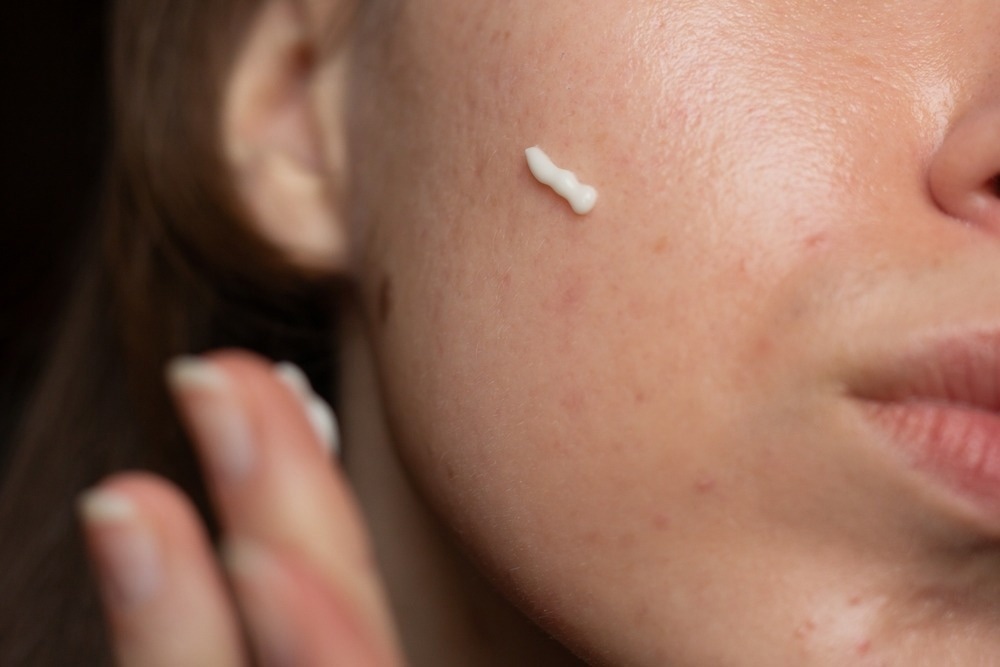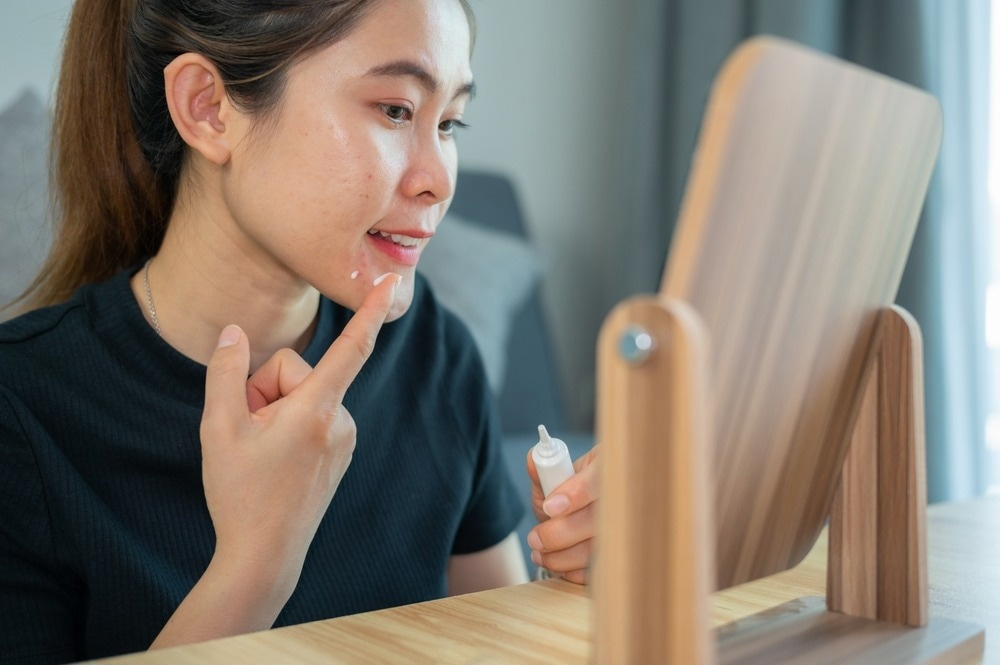Understanding retinoids
Retinoids in dermatology
Retinoids for anti-aging
The future of retinoids in skincare
Conclusion
References
Further reading
Retinoids are vitamin A derivatives responsible for regulating several physiological activities with profound importance in dermatology and skincare. They are the most widely utilized active ingredient in topical skin rejuvenation therapies. The various forms of retinoids have found a plethora of applications in dermatological and cosmetic care over the years. They are widely used to treat various skin conditions, including acne, wrinkles, skin cancer, ichthyosis, and psoriasis.

Image Credit: Anna Gawlik/Shutterstock.com
Understanding retinoids
The retinoid family includes various synthetic compounds of vitamin A and its natural derivatives. This consists of retinoic acid, retinyl esters, and retinaldehyde.
According to the molecular characteristics, retinoids are classified into three generations – first, second, and third. The former comprises natural retinoid compounds, including retinal and tretinoin, while the latter consists of synthetic monoaromatic compounds wherein benzene is replaced by cyclohexane, for example, acitretin and etretinate. The third-generation retinoids are polyaromatic and are created due to the cyclization of the polyene side chain. This group includes adapalene, arotinoid, and tazarotene.
Moreover, one of the primary physiologically active metabolites of vitamin A is ATRA (all-trans-retinoic acid). ATRA and other retinoids activate many cellular kinases in a highly cell-specific manner. There seems to be some limitation to the efficacy of ATRA in the skin because of ATRA-mediated resistance resulting from many multifactorial pathways.
Retinoids regulate the proliferation and differentiation of cells, thereby promoting skin healing. They attach to retinoic acid receptors via direct ligand-receptor binding and activate them to induce the transcription of retinoic acid‐responsive genes. This process is mediated by nuclear hormone receptors and CRBP (cytosolic binding proteins). CRBP and CRABP, or cytosolic retinoic acid-binding proteins, are the two types of retinoid receptors.
Retinol enhances the activity of fibroblasts, keratinocytes, Langerhans cells, and melanocytes. It interacts with receptors within keratinocytes and stimulates its proliferation. This then enhances the protective function of the epidermis and decreases transepidermal water loss. Further, it prevents the deterioration of shield collagen and blocks the action of metalloproteinases that break down the extracellular matrix. Furthermore, it promotes angiogenesis in the dermal papillary layer and improves the remodeling of reticular fibers.
Retinoids in dermatology
Retinoids are the most widely utilized active ingredient in topical skin rejuvenation therapies. They are widely used to treat various skin conditions, including acne, wrinkles, skin cancer, ichthyosis, and psoriasis. Disorders of pigmentation like melasma can also be treated using retinoids. By using new RAMBAs (retinoic acid metabolism-blocking agents), the regulation of endogenous ATRA concentration and its natural stereoisomers may lead to the development of new cancer therapeutic approaches as well as dermatological disease treatments.
According to the American Academy of Dermatology (AAD), common retinoids that can be used in various forms (gel, lotion, or cream) to manage acne are – adapalene, tretinoin, tazarotene, and tazarotene. They can be used alone or in combination with other products. Adapalene is thought to be the least effective acne treatment, although it is well-tolerated among other forms of retinoid. Tretinoin is known to have a moderate level of tolerance and efficacy. Although tazarotene has the highest efficiency, skin irritation makes it intolerable. Comparing adapalene 0.1% gel to tretinoin 0.025% gel, a meta-analysis comprising five randomized controlled trials revealed that the former was more tolerable and comparatively effective in treating acne.
Every group in a 12-week randomized trial comparing tazarotene 0.1% gel and adapalene 0.3% gel experienced a clinically significant decrease in the overall number of lesions. Adapalene treatment resulted in a 61% reduction in acne lesions, compared to a 57% reduction in the tazarotene group. The 0.3% gel of adapalene was as effective as the 0.1% gel of tazarotene. Adapalene users, however, reported less irritation.
Retinoids can also play an important role in treating hyperpigmentation caused by acne or other skin conditions. Hyperpigmentation is a common condition in people of color. Asians, Hispanics, and Blacks usually suffer from various forms of hyperpigmentation, including acne lesions and hyperpigmented macules.
Retinoids can also treat hyperpigmentation in conjunction with other topical medications and procedures, such as superficial chemical peels. Primary acne lesions can get better weeks before PIH (post-inflammatory hyperpigmentation) gets better, so helping patients set realistic expectations will help them feel less frustrated.
The chronic, complex disease known as psoriasis disrupts keratinocyte development and proliferation. Psoriasis has long been treated with retinoid therapy. This makes it possible to comprehend retinoic acid's function in skin physiology and disease on a deeper level.
It has been demonstrated that treating basal cell carcinomas (BCCs) with derivatives of retinoic acid is beneficial. An early study found that topical 0.05% tretinoin effectively regressed BCCs. However, once treatment ended, recurrence rates were high. Clinical investigations showed more promise for tazarotene creams.

Image Credit: Boyloso/Shutterstock.com
Tazarotene, a derivative of retinoic acid, was shown in a clinical investigation to be beneficial in the treatment of BBCs. There was a regression of basaliomatous cells, which was linked to higher apoptosis and decreased proliferation. Fenretinide, another retinoid, is carcinogenic to skin tumor cells as well as other cancerous cells.
Retinoids for anti-aging
Skin aging due to chronology or inherent factors happens as time passes. Clinically, there are fine wrinkles, and the skin looks dry and atrophic. However, it is acknowledged that external or environmental variables have a bigger impact on the look of skin, making them appropriate targets for "antiaging" therapy.
Sunlight's ultraviolet radiation (UVR) is widely acknowledged to be the main environmental element causing extrinsic aging or photoaging. There is a dose-response association between pack-years of smoking and wrinkles, indicating that tobacco use is an independent risk factor for accelerated skin aging. It is well known that air pollution contributes to extrinsic skin aging, causing wrinkles and dyspigmentation.
Retinoids play a crucial role in the anti-aging process of the skin. The various forms of retinoids have found a plethora of applications in dermatological and cosmetic care over the years. Retinol helps in the management of wrinkles, fine lines, and skin textures. Retinyl esters and retinaldehyde have stabilizing properties and can facilitate the treatment of wrinkles.
The effectiveness of 0.05% and 5% tretinoin cream on numerous actinic keratosis and photoaged skin was examined in a study. Improvement in skin photoaging was observed after the treatment.
The future of retinoids in skincare
An area of investigation that has led to novel medicines in acne therapy is combination therapies with topical retinoids. The utilization of combination therapy with topicals has proven to be helpful from the perspective of a multimodal mechanism of action. It potentially minimizes the necessity for oral medication and systemic exposure. New topical retinoids and these agents being coupled with other well-proven topical therapies will come as no surprise, given the prevalence of acne in both adults and children. Formulating compounds in new vehicles that support the stability of products and lessen their adverse effects is also of interest.
Despite several decades of biochemical and clinical research, there are still several obstacles to using retinoids to prevent and treat skin cancer. First, there are new retinoid compounds that haven't been well-tested for their potential to treat skin cancer. The clinical translations of basic research findings are not fully informed. To minimize adverse effects and maximize the utility of retinoids in the treatment of skin cancer, rational medication combinations incorporating these chemicals may be essential.
Therefore, the identification of therapeutic biomarkers to assess retinoid response and anticipate resistance may be a promising area of research in the future, perhaps leading to the selection of patients most likely to benefit from retinoid therapy.
Conclusion
Over the years, first-generation tretinoin—which is still a popular therapeutic option for many dermatologists—has given way to topical retinoids. The third and fourth-generation retinoids, which have improvements in potency, tolerability, photostability, and other indications, were discovered as a result of ongoing research into these drugs.
Characterizing the molecular genetics of retinoid response and applying this understanding to treatment design, prognostication, and patient selection optimization can be productive research directions. Such studies can help direct the use of retinoids in dermatology in the future, ushering in the era of precision medicine.
References
- Tolaymat L, Dearborn H, Zito PM. Adapalene. [Updated 2023 Jun 26]. In: StatPearls [Internet]. Treasure Island (FL): StatPearls Publishing; 2023 Jan-. Available from: https://www.ncbi.nlm.nih.gov/books/NBK482509/
- Tan J, Chavda R, Baldwin H, Dreno B. Management of Acne Vulgaris With Trifarotene. J Cutan Med Surg. 2023 Jul-Aug;27(4):368-374. doi: 10.1177/12034754231163542. Epub 2023 Mar 16. PMID: 36927117; PMCID: PMC10486177.
- Griffiths TW, Watson REB, Langton AK. Skin ageing and topical rejuvenation strategies. Br J Dermatol. 2023 Oct 30;189(Suppl 1):i17-i23. doi: 10.1093/bjd/ljad282. PMID: 37903073.
- Callender VD, Baldwin H, Cook-Bolden FE, Alexis AF, Stein Gold L, Guenin E. Effects of Topical Retinoids on Acne and Post-inflammatory Hyperpigmentation in Patients with Skin of Color: A Clinical Review and Implications for Practice. Am J Clin Dermatol. 2022 Jan;23(1):69-81. doi: 10.1007/s40257-021-00643-2. Epub 2021 Nov 9. PMID: 34751927; PMCID: PMC8776661.
- Ramchatesingh B, Martínez Villarreal A, Arcuri D, Lagacé F, Setah SA, Touma F, Al-Badarin F, Litvinov IV. The Use of Retinoids for the Prevention and Treatment of Skin Cancers: An Updated Review. Int J Mol Sci. 2022 Oct 20;23(20):12622. doi: 10.3390/ijms232012622. PMID: 36293471; PMCID: PMC9603842.
- Motamedi M, Chehade A, Sanghera R, Grewal P. A Clinician's Guide to Topical Retinoids. J Cutan Med Surg. 2022 Jan-Feb;26(1):71-78. doi: 10.1177/12034754211035091. Epub 2021 Jul 22. PMID: 34292058; PMCID: PMC8750127.
- Szymański Ł, Skopek R, Palusińska M, Schenk T, Stengel S, Lewicki S, Kraj L, Kamiński P, Zelent A. Retinoic Acid and Its Derivatives in Skin. Cells. 2020 Dec 11;9(12):2660. doi: 10.3390/cells9122660. PMID: 33322246; PMCID: PMC7764495.
- Zasada M, Budzisz E. Retinoids: active molecules influencing skin structure formation in cosmetic and dermatological treatments. Postepy Dermatol Alergol. 2019 Aug;36(4):392-397. doi: 10.5114/ada.2019.87443. Epub 2019 Aug 30. PMID: 31616211; PMCID: PMC6791161.
Further Reading